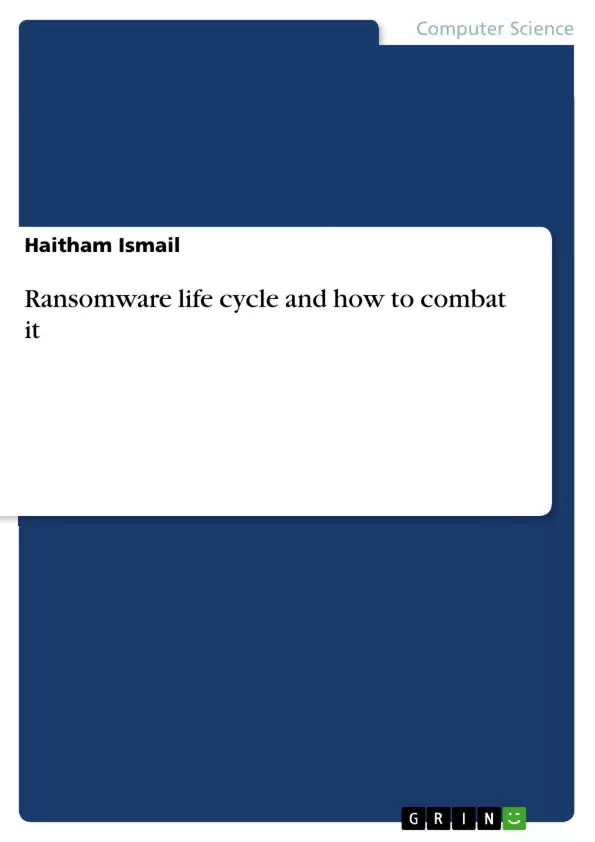Ransomware is a dangerous malware which causes high financial loses for organizations. It is usually installed using a type of privilage esclation attack and then it encrypts data, asking for a ransom. In this paper, we will analyze ransomware life cycle and answer the question how to arrange your information security defences to combat ransomware outbreak.
Information is an important asset for individuals, organisations, and governments. Stealing confidential information such as credit card numbers or Intellectual properties can cause financial loss or reputation damage. For example, Organisations invest in research creating intellectual property to secure their future earnings and pursue innovation. Because of that, Rao & Nayak (2014) state that intellectual property is valuable assets that need to be protected from theft or unauthorised access as it will cost mainly a severe financial loss. Chai, et al. (2016) state that individuals might be subjected to electronic bullying and harassments through internet social media like Facebook and Twitter. Most of the cases, protecting customer’s information is protected by law which means that the theft of customer’s sensitive information such as personal identifiable information (PII) and protected health information (PHI) will cause organisations to pay fines that consider also as a financial loss and reputation damage. In Healthcare industry, unauthorised modification on medical records can cause human life losses.
Hammondl (2013) states that effective information security addresses the security triad (Confidentiality, Integrity & Availability). Confidentiality grantees that sensitive information (e.g. PHI, PII, Credit card, etc.) accessed by those who have the authority to access them. On the other hand, Integrity is making sure that data is protected against unauthorised malicious or non-intention modifications (Hammondl, 2013). Finally, availability grantees that information is available for the right person when it's needed and access granted.
BBC (2017) reported in 12th of May an example that shows how important information security is to our life. Information security was violated by a massive cyber-attack hit NHS services across England and Scotland resulting hospital operation disruption and GP appointments that make staff uses pen and papers.
Table of Contents
- Part 1
- A. The Importance of Information Security
- B. What is Ransomware, its history and how does it works?
- C. In-depth discussion of the vulnerability of the system which led to the wanacry ransomware attack
- D. The impacz of this type of attack on confidentiality, integrity and availability of data and resources being attacked
- Part 2:
- Discussion of basic guidelines and security safeguard measures that can be applied to this scenario to mitigate the chances of future attack.
Objectives and Key Themes
This document explores the concept of ransomware and its impact on information security. It analyzes the vulnerabilities that led to the WannaCry ransomware attack and discusses the consequences for data confidentiality, integrity, and availability. Additionally, the document examines potential security measures to mitigate future ransomware attacks.
- Importance of Information Security
- Ransomware: Definition, History, and Working Mechanism
- Vulnerabilities Leading to the WannaCry Attack
- Impact of Ransomware on Data Confidentiality, Integrity, and Availability
- Security Safeguards for Mitigating Ransomware Attacks
Chapter Summaries
The first part of the document examines the significance of information security, emphasizing its role in protecting sensitive data such as financial information and intellectual property. It highlights the legal and ethical implications of data breaches, including potential financial losses and reputational damage. The chapter also introduces the concept of the security triad, comprising confidentiality, integrity, and availability.
The second part delves into the concept of ransomware, tracing its history and explaining its operational mechanisms. The chapter then explores the vulnerability of systems that led to the WannaCry ransomware attack, analyzing the specific security weaknesses that facilitated the breach.
Part 1 concludes by discussing the impact of ransomware attacks on data confidentiality, integrity, and availability. The document provides real-world examples of the consequences of such attacks, including disruptions to critical services and potential loss of life in the healthcare industry.
Part 2 focuses on preventive measures to mitigate the risk of future ransomware attacks. It outlines essential security guidelines and safeguard measures, aiming to enhance system resilience and protect against malicious actors.
Keywords
The core keywords and focus topics in this document encompass: information security, ransomware, data confidentiality, data integrity, data availability, vulnerability analysis, security safeguards, WannaCry attack, cyber-attacks, data protection, and ethical considerations.
- Quote paper
- Haitham Ismail (Author), 2017, Ransomware life cycle and how to combat it, Munich, GRIN Verlag, https://www.grin.com/document/455229



